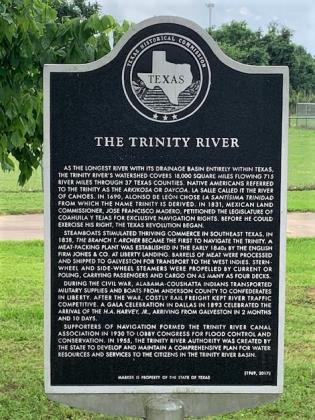THE TRINITY RIVER MARKER
The Trinity River has been known by many names in recorded history, but the present name was given by General Alonso de Leon, in about 1690 while traveling into the territory of “Los Tejas Indios” with Fray Damian Massanet. De Leon noted in his diary on 19th May 1690 arriving at a large and pleasant valley to which we gave the name of La Valle de la Santissima Trinidad which translates the Valley of the Most Holy Trinity. As was the custom of Spanish explorers, rivers ands prominent landmarks were named for religious feasts or Holy Days. The name Rio de la Santissima Trinidad has been Anglicized and shortened to “Trinity River.”
The Trinity is the longest river located entirely within Texas. The watershed of the Trinity covers 17,969 square miles, larger than any of the smaller states in the union. The first recorded exclusive navigation rights to the Trinity were given by Mexico in 1833 to District Commissioner J. Francisco Madero but before he could exercise his right, the Texas Revolution had commenced.
As early as 1838, during the Republic of Texas era, steamboat navigation had begun on the Trinity. By 1840, Liberty was a prominent port on the river and the Trinity offered transportation to and from Galveston. The largest and best-known steamships were the Mary Conley, Scioto Belle, Black Cloud, Bettye Powell, Early Bird and Star State. These ships had a regular passenger trade and mail route . There were several landings along the river where the ships would deposit passengers, provisions, and mail to the settlers. Until 1874, steamers traveled from Galveston to as far north as Porters’ Bluff, 50 miles below Dallas. Some of the goods included cow and deer hides, food supplies, beeswax, and cotton. In the early 1840s, a meat packing plant was established at Liberty Landing on the Trinity by an English firm, Jones & Co. During this period cattle became an important industry in Liberty County and transport was necessary. The Liberty plant processed beef by placing in iron cylinders and air was then expelled, causing a vacuum. Brine was then added. When the beef was removed, it was packed in salt and shipped to Galveston by steamer on the Trinity River and on to the West Indies in English sailing vessels. Nothing was wasted, the first made candles, tallow, neat’s-foot oil, and glue, as well as leather, knife handles and other utensils from the horns; in fact, they utilized every part of the animal.
Following a convention on Trinity improvement in 1849 at Huntsville, the U. S. Congress authorized a survey of the river in 1852. The next year an army engineer’s report stated that the Trinity River was the deepest and least obstructed river in Texas. During the Civil War, the river played a vital rose when a company of Alabama-Coushatta Indians transported key military supplies and boats from Anderson County to waiting Confederate officials in Liberty. During the season of 1868-69, after the War, boats carried 15,425 bales of cotton down the Trinity. After the construction of railroads to Dallas in the early 1870s, river traffic began to die but the high railroad rates and Dallas as a major port kept the dream of a navigable Trinity River alive.
Under the River and Harbor Act of 1865, Congress authorized the comprehensive development of the Trinity Basin’s water resources. Although numerous schemes to make the Trinity navigable have been proposed, several receiving considerable attention and some construction was undertaken, the dream of a port of Dallas has never been realized.
Texas Historical Commission Subject Marker 1970
Located on the Southeast side of the Trinity River Bridge at Liberty, TX.

